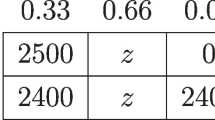Abstract
The diversification bias in repeated lotteries is the finding that a majority of participants fail to select the option offering the highest probability. This phenomenon is systematic and immune to classical manipulations (e.g. monetary rewards). We apply dual process theories and argue that the diversification bias is a consequence of System 1 (automatic, intuitive, associative) triggering a matching response, which fails to be corrected by System 2 (intentional, analytic, rational). Empirically, supporting the corrective functions of System 2 through appropriate contextual cues (describing the task as a statistical test rather than as a lottery) led to a decrease of diversification.
Similar content being viewed by others
Notes
Even without replacement p(green) is maximal, since there are 11 green cards more than cards of any other color and only five draws. Although strict independence is not applicable to our task (which is without replacement), we will use this notion in its loose sense, of quasi-independence.
References
Arkes, Hal R., Robyn M. Dawes, and Caryn Christensen. (1986). “Factors Influencing the Use of a Decision Rule in a Probabilistic Task,” Organizational Behavior and Human Decision Processes 37, 93–110.
Baron, Jonathan, Leonardo Granato, Mark Spranca, and Eva Teubal. (1993). “Decision Making Biases in Children and Early Adolescents: Exploratory Studies,” Merril Palmer Quarterly 39, 23–47.
Chaiken, Shelly, and Yaacov Trope (eds.). (1999). Dual-Process Theories in Social Psychology. New York: Guilford.
Epstein, Seymour. (1994). “Integration of the Cognitive and Psychodynamic Unconscious,” American Psychologist 49, 709–724.
Estes, William K., and J. H. Straughan. (1954). “Analysis of a Verbal Conditioning Situation in Terms of Statistical Learning Theory,” Journal of Experimental Psychology 47, 225–234.
Fantino, Edmund, and Ali Esfandiari. (2002). “Probability Matching: Encouraging Optimal Responding in Humans,” Canadian Journal of Experimental Psychology 56, 58–63.
Fisher, Wayne W., and James E. Mazur. (1997). “Basic and Applied Research on Choice Responding,” Journal of Applied Behavior Analysis 30, 387–410.
Friedman, Daniel, Dominic W. Massaro, Stephen Kitzis, and Michael Cohen. (1995). “A Comparison of Learning Models,” Journal of Mathematical Psychology 39, 164–178.
Gal, Ido, and Jonathan Baron. (1996). “Understanding Repeated Simple Choices,” Thinking and Reasoning 2, 81–98.
Gallistel, Charles R. (1990). The Organization of Learning. Cambridge, MA: MIT.
Gilbert, Daniel T. (1989). “Thinking Lightly About Others: Automatic Components of the Social Inference Process.” In James Uleman and John A. Bargh (eds.), Unintended Thought (pp. 189–211). Englewood Cliffs, NJ: Prentice-Hall.
Gilbert, Daniel T. (1999). “What the Mind’s Not.” In Shelly Chaiken and Yaacov Trope (eds.), Dual-process Theories in Social Psychology (pp. 3–11). New York: Guilford.
Goel, Vinod, and Raymond Dolan. (2003). “Explaining Modulation of Reasoning by Belief,” Cognition 87, B11–B22.
Healy, Alice F., and Michael Kubovy. (1981). “Probability Matching and the Formation of Conservative Decision Rules in a Numerical Analog of Signal Detection,” Journal of Experimental Psychology: Human Learning and Memory 7, 344–354.
Herrnstein, R. J. (1961). “Relative and Absolute Strength of Response as a Function of Frequency of Reinforcement,” Journal of the Experimental Analysis of Behavior 4, 267–272.
Kacelnik, Alex, and Melissa Bateson. (1997). “Risk-sensitivity: Crossroads for Theories of Decision-making,” Trends in Cognitive Sciences 1, 304–309.
Kahneman, Daniel. (2003). “A Perspective on Judgement and Choice: Mapping Bounded Rationality,” American Psychologist 58, 697–720.
Kahneman, Daniel, and Shane Frederick. (2002). “Representativeness Revisited: Attribute Substitution in Intuitive Judgement.” In Thomas Gilovich, Dale Griffin, and Daniel Kahneman (eds.), Heuristics and Biases: The Psychology of Intuitive Judgment (pp. 49–81). New York: Cambridge University Press.
Kogler, Christoph. (2006). “How Robust is the Diversification Bias? The Role of Dual Cognitive Process-theories in Multiple Decision Problems with Objective Probabilities.” Ph.D., University of Salzburg.
Kogler, Christoph, and Anton Kühberger. (2006). “Dual Process Theories and the Diversification Bias.” In Bartosz Gula, Rainer Alexandrowizc, Sabine Strauß, Eva Brunner, Barbara Jenull-Schiefer, and Oliver Vitouch (eds.), Perspektiven psychologischer Forschung in Österreich (pp.62–70). Lengerich: Pabst.
Loomes, Graham. (1998). “Probability vs. Money: A Test of Some Fundamental Assumptions about Rational Decision Making,” The Economic Journal 108, 477–489.
Myers, Jerome L., Jane G. Fort, Leonard Katz, and Mary M. Suydam. (1963). “Differential Memory Gains and Losses and Event Probability in a Two-choice Situation,” Journal of Experimental Psychology 66, 521–522.
Read, Daniel, and George Loewenstein. (1995). “Diversification Bias: Explaining the Discrepancy in Variety Seeking Between Combined and Separate Choices,” Journal of Experimental Psychology: Applied 1, 34–49.
Rohde, Catrin, Leda Cosmides, Wolfgang Hell, and John Tooby. (1999). “When and Why do People Avoid Unknown Probabilities in Decisions Under Uncertainty? Testing Some Predictions from Optimal Foraging Theory,” Cognition 72, 269–304.
Rubinstein, Ariel. (2002). “Irrational Diversification in Multiple Decision Problems,” European Economic Review 46, 1369–1378.
Shanks, David R., Richard J. Tunney, and John D. McCarthy. (2002). “A Re-examination of Probability Matching and Rational Choice,” Journal of Behavioral Decision Making 15, 233–250.
Simonson, Itmar. (1990). “The Effect of Purchase Quantity and Timing on Variety Seeking Behavior,” Journal of Marketing Research 32, 150–162.
Stanovich, Keith E., and Richard F. West. (2000). “Individual Differences in Reasoning: Implications for the Rationality Debate,” Behavioral and Brain Sciences 23, 645–726.
Stanovich, Keith E., and Richard F. West. (2002). “Individual Differences in Reasoning: Implications for the Rationality Debate?” In Thomas Gilovich, Dale W. Griffin, and Daniel Kahneman (eds.), Heuristics and Biases: The Psychology of Intuitive Judgment (pp. 421–440). New York: Cambridge University Press.
Suppes, Patrick, and Richard C. Atkinson. (1960). Markov Learning Models for Multiperson Interactions. Stanford: Stanford University Press.
Vulkan, Nir. (2000). “An Economist’s Perspective on Probability Matching,” Journal of Economic Surveys 14, 101–118.
West, Richard F., and Keith E. Stanovich. (2003). “Is Probability Matching Smart? Associations Between Probabilistic Choices and Cognitive Ability,” Memory & Cognition 31, 243–251.
Author information
Authors and Affiliations
Corresponding author
Rights and permissions
About this article
Cite this article
Kogler, C., Kühberger, A. Dual process theories: A key for understanding the diversification bias?. J Risk Uncertainty 34, 145–154 (2007). https://doi.org/10.1007/s11166-007-9008-7
Published:
Issue Date:
DOI: https://doi.org/10.1007/s11166-007-9008-7




